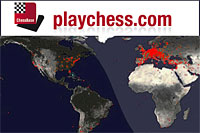
6th Lucopen in Lille – Part 2
Report from France by Sagar Shah

The two GM norms: IM Quentin Louiseau, who also won the tournament, IM Sagar Shah
For a 2600+ performance you have need two things: consistency and luck. I was lucky enough to play against all the top four seeds of the tournament. Surely, this was a fortunate fact as I could have faced much lower rated opponents. But I also played consistently making three draws and beating Vladimir Burmakin. There were two things that I did differently in this tournament.
-
I made sure to get away from Facebook and Whatsapp for seven days of the tournament. By not checking the updates and messages it kept my mind free to focus on much more important things and not getting tired by dwelling on what other people have to say.
-
Before I left my room for the playing hall, I made sure that I would solve ten minutes of tactical problems. Of course there are many books or databases for that, but I really loved working on the new interactive website that ChessBase has come up with. The problems were not too difficult, but that was exactly what I needed. The fact that you earn rating points for every correct move and lose them for incorrect ones keeps you on your toes. As my friend IM K. Ratnakaran from India, once told me, “solving light problems just before the round helps you to avoid tactical mistakes in the first few minutes of the game as you have already got your brain working!”
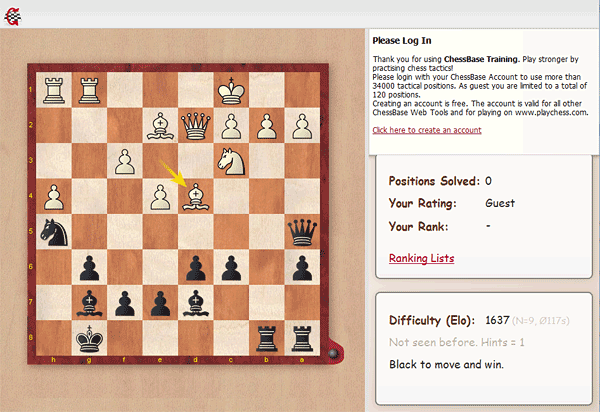
But of course mistakes are unavoidable no matter how hard you try. But, it is simply an inexplicable feeling when one of your mistakes actually becomes a wonderful concept and helps you win the game! Unable to understand what I just said? Have a look at my second round game of the event.
| 1.e4 | 1,184,215 | 54% | 2421 | --- |
| 1.d4 | 958,932 | 55% | 2434 | --- |
| 1.Nf3 | 286,327 | 56% | 2441 | --- |
| 1.c4 | 184,722 | 56% | 2443 | --- |
| 1.g3 | 19,884 | 56% | 2427 | --- |
| 1.b3 | 14,598 | 54% | 2428 | --- |
| 1.f4 | 5,953 | 48% | 2377 | --- |
| 1.Nc3 | 3,906 | 50% | 2384 | --- |
| 1.b4 | 1,790 | 48% | 2378 | --- |
| 1.a3 | 1,250 | 54% | 2406 | --- |
| 1.e3 | 1,081 | 49% | 2409 | --- |
| 1.d3 | 969 | 50% | 2378 | --- |
| 1.g4 | 670 | 46% | 2361 | --- |
| 1.h4 | 466 | 54% | 2382 | --- |
| 1.c3 | 439 | 51% | 2425 | --- |
| 1.h3 | 289 | 56% | 2420 | --- |
| 1.a4 | 118 | 60% | 2461 | --- |
| 1.f3 | 100 | 47% | 2427 | --- |
| 1.Nh3 | 92 | 67% | 2511 | --- |
| 1.Na3 | 47 | 62% | 2476 | --- |
Please, wait...
1.e4 c6 2.Ne2!? d5 3.e5 d4 3...Bf5 4.Ng3 Bg6 5.h4 h6 6.h5 Bh7 7.e6! fxe6 8.d4 4.c3 4.b4 f6 4...c5 5.b4 d3 5...cxb4 6.Nxd4 6.Nf4 c4 7.e6 7.Na3 g5 7...Qc7 8.Nd5 Qxe5+ 8...Qc6 9.Ne3 Be6 10.Qa4+ Nd7 11.Qb5 Ngf6 12.Qxe5 Nxe5 13.f4 Neg4 14.Naxc4 0-0-0 8.e6 gxf4 9.exf7+ Kxf7 10.Qh5+ Kg7 11.Qg5+ Kf7 12.Qh5+= 7...Nf6N 7...Qc7 8.Qf3 Nf6 9.Na3 fxe6 10.g3 Qe5+ 11.Qe3 Qxe3+ 12.fxe3 e5 13.Nh3 Be6 14.Ng5 Bd5 15.e4 Nxe4 16.Bg2 Nxc3 17.Bxd5 Nxd5 18.Nxc4 Nd7 19.Bb2 Rc8 20.Rc1 N5b6 21.Na5 Rxc1+ 22.Bxc1 e6 23.a3 Be7 24.Nxe6 Kf7 25.Nc7 Rc8 26.0-0+ Nf6 27.Nb5 a6 28.Nc3 Rc7 29.Bb2 Kg6 30.Re1 Kf5 31.Re3 e4 32.g4+ Nxg4 33.Rxe4 Bf6 34.Re8 Bd4+ 35.Kf1 Nxh2+ 36.Kg2 Ng4 37.Rd8 Rd7 38.Rxd7 Nxd7 39.Nxb7 Nge5 40.Nd1 Bxb2 41.Nxb2 h5 42.a4 h4 43.Nd1 Nc4 44.Nf2 Nde5 45.Nc5 Nxd2 46.b5 axb5 47.axb5 Ndc4 48.Ncxd3 Nf7 49.Ne1 Nfe5 50.Nc2 g5 51.Nd4+ Kg6 52.Ne6 Kf6 53.Nd4 Kg6 54.Ne6 Kf6 55.Nd4 Ne3+ 56.Kh3 Nd5 57.Ng4+ Nxg4 58.Kxg4 Kg6 59.b6 Nxb6 8.Qa4+ Nbd7!? 8...Nc6? 9.b5 Ne5 10.b6+ Nc6 10...Nfd7 11.Nd5!+- 11.Qxc4± 9.exd7+ Bxd7 10.Qa5 10.Qd1 Qc7 11.Qf3 Bc6 10...Qb8 10...Qxa5 11.bxa5 10...b6 11.Qe5 11.Nd5 11.Nxd3 cxd3 12.Bxd3 e5 11...Nxd5! 11...e6 12.Nc7+ 11...b6 12.Nxf6+ exf6 13.Qd5 11...Qe5+ 12.Ne3 12.Qxd5 Bc6! 13.Qd4 13.Qxc4 Qe5+ 14.Kd1 Ba4+-+ 13.Qg5!? b5 13...b5 14.a4 14.Bxd3 cxd3 15.0-0 e5 16.Qxd3 Bd6 14.f4 Qb7 15.a4 Rd8 16.Qf2 a6 17.axb5 axb5 14...e5 15.Qe3 15.Qg4 a6 16.axb5 axb5 17.Rxa8 Bxa8 17...Qxa8 18.Na3 Bc6 19.Nxc4 h5! 15...a6 15...bxa4 16.Na3! Bd5 17.Nxc4 Bxc4 18.Bxd3± 16.f3? 16.Bxd3 cxd3 17.0-0 e4 16...Bd6 17.g3 0-0 18.Bg2 Bc7 19.a5 Qb7 20.0-0 Bb8 21.Kh1 Ba7 22.Qg5 22.Qxe5 Rae8-+ 22...e4 23.Qf4 Rae8 24.Na3 24.fxe4 Rxe4! 25.Qf3 Re6-+ 24...Bb8 24...Bb8 25.Qe3 exf3 26.Qxf3 Re1-+ 0–1
- Start an analysis engine:
- Try maximizing the board:
- Use the four cursor keys to replay the game. Make moves to analyse yourself.
- Press Ctrl-B to rotate the board.
- Drag the split bars between window panes.
- Download&Clip PGN/GIF/FEN/QR Codes. Share the game.
- Games viewed here will automatically be stored in your cloud clipboard (if you are logged in). Use the cloud clipboard also in ChessBase.
- Create an account to access the games cloud.
| Henris,L | 2153 | Sagar,S | 2436 | 0–1 | 2015 | B10 | Lucopen Lille | 2 |
Please, wait...
Final standings (after nine rounds)
| Pl |
Ti. |
Nom |
Elo |
Pts |
Tr. |
Perf |
Bu. |
| 1 |
m |
Loiseau Quentin |
2415 |
7 |
45½ |
2644 |
56 |
| 2 |
g |
Gharamian Tigran |
2647 |
7 |
45 |
2653 |
56 |
| 3 |
g |
Demuth Adrien |
2515 |
7 |
45 |
2602 |
54½ |
| 4 |
g |
Chatalbashev Boris |
2541 |
7 |
45 |
2564 |
55½ |
| 5 |
g |
Zhigalko Andrey |
2586 |
7 |
43 |
2577 |
52½ |
| 6 |
g |
Burmakin Vladimir |
2585 |
7 |
42½ |
2549 |
53 |
| 7 |
f |
Martynov Pavel |
2376 |
7 |
40 |
2422 |
47½ |
| 8 |
m |
Sagar Shah |
2436 |
6½ |
45½ |
2608 |
55½ |
| 9 |
m |
Le Quang Long |
2405 |
6½ |
41½ |
2418 |
50 |
| 10 |
m |
Van Foreest Jorden |
2519 |
6½ |
40½ |
2385 |
49½ |
| 11 |
m |
Dourerassou Jonathan |
2414 |
6½ |
40 |
2364 |
48 |
| 12 |
m |
Bailet Pierre |
2519 |
6 |
45 |
2495 |
55½ |
| 13 |
g |
Maiorov Nikita |
2563 |
6 |
43 |
2449 |
53 |
| 14 |
m |
Terrieux Kevin |
2439 |
6 |
43 |
2412 |
52 |
| 15 |
g |
Karpatchev Aleksandr |
2466 |
6 |
43 |
2411 |
52½ |
| 16 |
g |
Naumkin Igor |
2445 |
6 |
43 |
2360 |
53½ |
| 17 |
m |
Shirazi Kamran |
2385 |
6 |
42 |
2427 |
51 |
| 18 |
f |
Di Nicolantonio Lucas |
2414 |
6 |
41½ |
2401 |
51½ |
| 19 |
g |
Manolache Marius |
2498 |
6 |
41½ |
2378 |
49½ |
| 20 |
|
Midoux Sebastien |
2315 |
6 |
40 |
2303 |
48 |
| 21 |
|
Guezennec Franck |
2231 |
6 |
38½ |
2195 |
47½ |
| 22 |
|
Van Foreest Lucas |
2312 |
6 |
38 |
2289 |
46 |
| 23 |
g |
Strikovic Aleksa |
2526 |
6 |
37½ |
2329 |
46 |
| 24 |
f |
Bannink Bernard |
2267 |
6 |
36½ |
2201 |
44 |
| 25 |
|
Frederic Clement |
2231 |
6 |
35½ |
2122 |
43 |
| 26 |
|
Majhi Ankit |
2178 |
6 |
32 |
2070 |
38 |
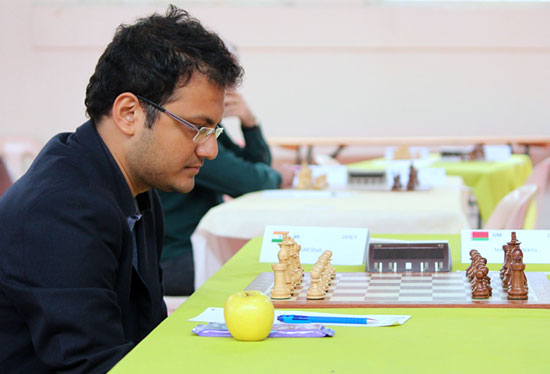
Eighth: The author of this report had a great tournament and made his second GM norm
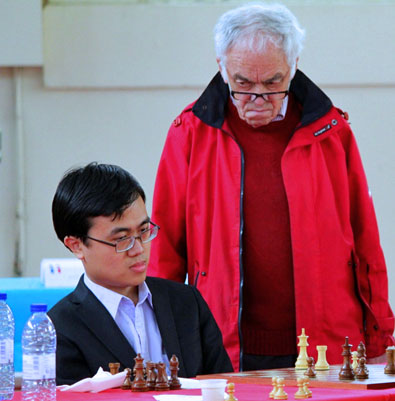
IM Le Quang Long (picture above, with a kibitzer who seems to say, “Son, you need to study your classics!”) finished ninth in the event. He is the brother of the world famous grandmaster Le Quang Liem. Long currently studies in France, and is doing his PhD in Nanotechnology. He came to the tournament only as a vacation but performed very well, beating GM Boris Chatalbashev who finished fourth.
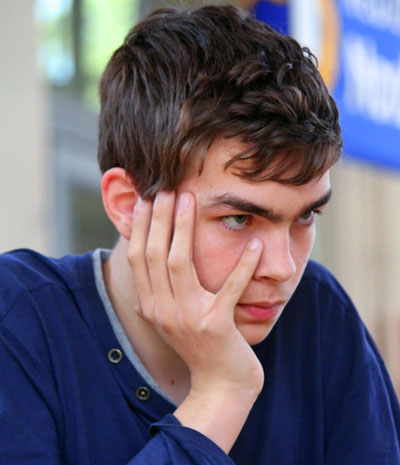
The talented Dutch IM Jorden Van Foreest (2519) had a mediocre event, finishing tenth
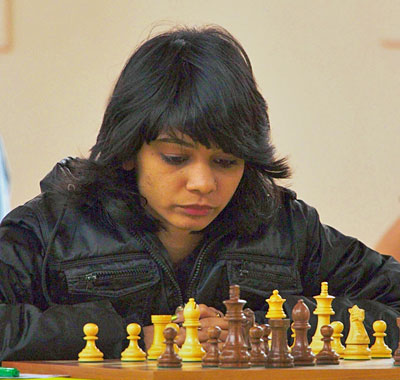
The photographer of this report and WIM elect Amruta Mokal won
the prize for the best woman player at the event [picture by Ronald Flou]
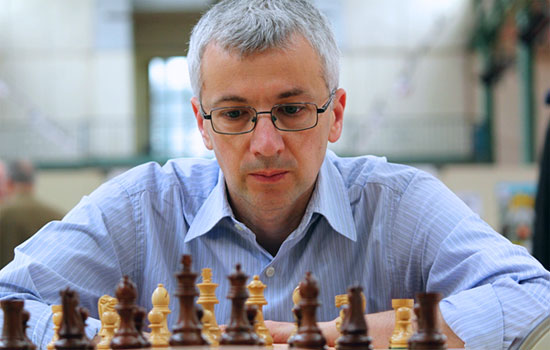
GM Marius Manolache from Romania wasn’t at his best but featured
in two of the games annotated by the top finishers in our previous article
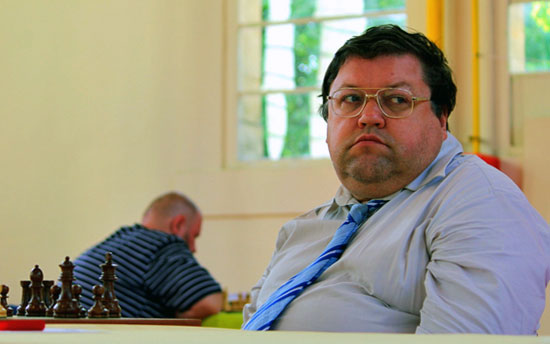
GM Igor Naumkin from Russia
Naumkin is one of the very few professional players in the world who do not carry a laptop to the tournament. He doesn’t prepare for his games and plays on his excellent positional judgement that he has acquired over the years.

GM Alexander Karpatchev, the early leader of the tournament with
4.0/4, found the going tough in the second half as he scored 6.0/9

IM Kamran Shirazi from France
Kamran was born and spent nearly 35 years of his life in Iran. He then shifted to USA and stayed there for twelve years. Once, when he came on a vacation to Paris, he fell in love with the city to such an extent that he left USA for good and made Paris his permanent residence! He has also worked in the movie ‘Searching for Bobby Fischer’ where he played the role of a grandmaster playing a game of blitz with the hustlers on the street. He already has three GM norms and had reached a live rating of 2499.1. At the age of 62 he still plays very strong chess and is trying to become a grandmaster.
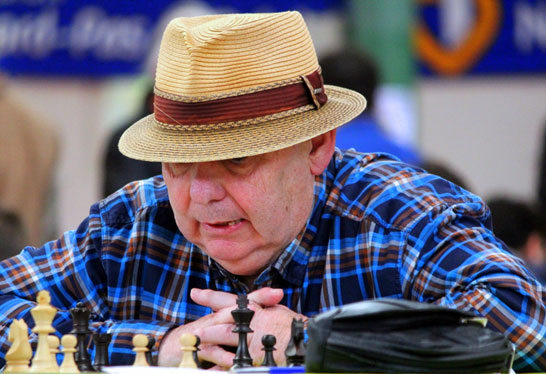
The style quotient was quite high at the Lucopen

That’s true passion for the game
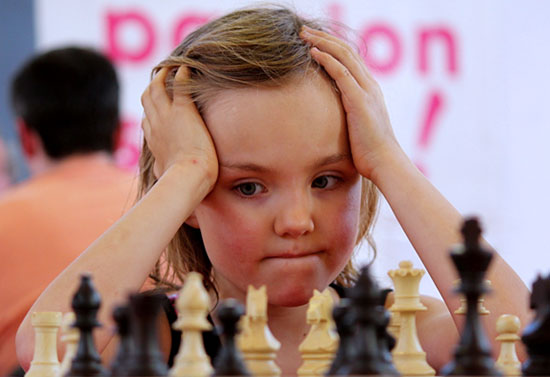
Fascinated by the wooden pieces
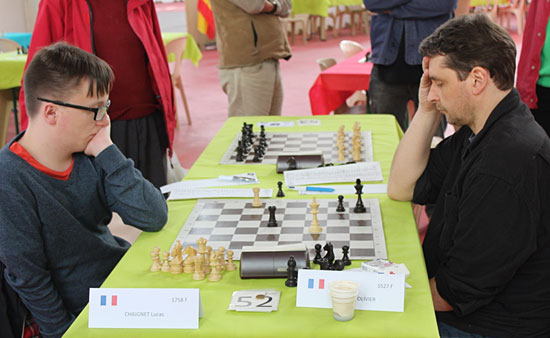
Building the bridge or the Lucena position in the rook endgame was found way back
in 1634 by Alessandro Salvio, but it has stood the test of time and now it is
one of the most important positions that should be known by every chess player.
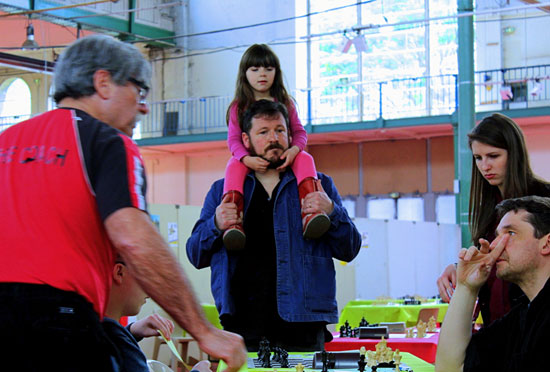
The most comfortable seat to watch the games
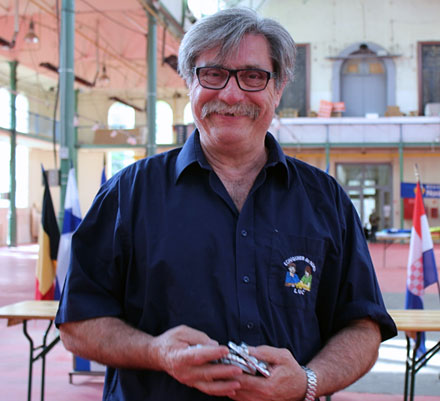
The organiser of the event, Serge Weill, was lively, friendly and
made the players feel extremely comfortable with great hospitality
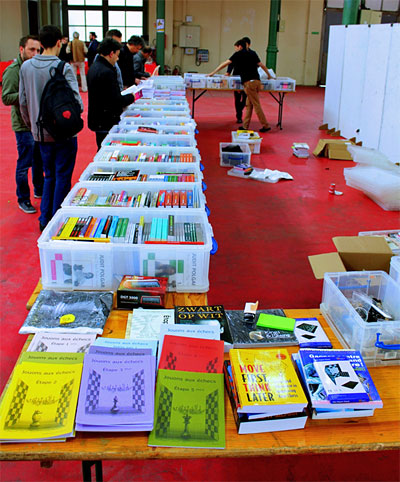
At the end of the last round a huge book shop was set up with titles from almost every publisher
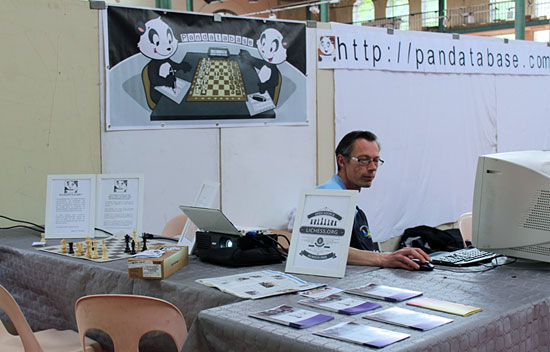
Pandatabase (see this Facebook page) was a novelty at this event
Pandatabase was a project introduced by one of the students at the event. The score sheets were such that they could be read by a scanner. So if you wrote your games in decent handwriting and submitted the games, the score sheets would be scanned and the games would be directly uploaded on the website, with some analysis as well!

However, there were a few technical difficulties. The handwritings of all the players were not so great and the machine couldn’t pick it up so well, and also the notation had to be in French. So the normal English notation of K for the king and Q for the queen would not be read. Yet, this seemed like a pretty interesting innovation. We promise you a full report in the near future.

The players were treated to some delicious macaroons at the end of the event

A number of beautiful cathedrals adorn the streets of Lille

La Statue du General Faidherbe at the Republic Square

The Palace of Fine Arts (Palais des Beaux-Arts) in Lille

There were a few streets in Lille which were closed for vehicles. That meant that you
could enjoy walking on these cobbled streets as you indulged in window shopping…

….or you could just sit outside a typical café and enjoy the atmosphere

There was also a zoo near the playing venue, with exotic species like the Red Panda …

… or this white owl
Pictures by Amruta Mokal














































